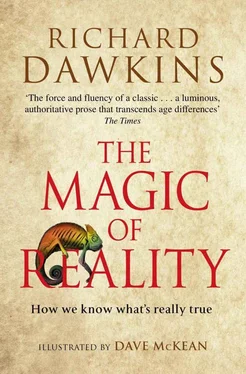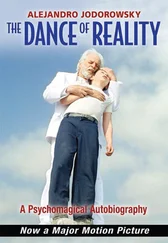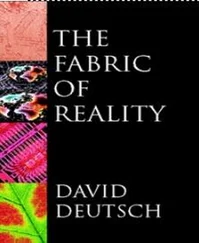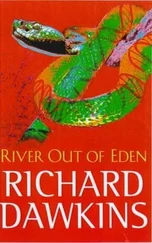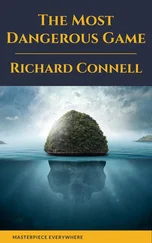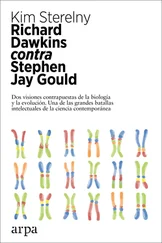Or, if the aliens have evolved organs that can handle radio waves for communication, they might also evolve true radar to find their way around, and radar does work in fog. On our planet, there are fish that have evolved the ability to find their way about using distortions in an electric field that they themselves create. In fact, this trick has evolved twice independently, in a group of African fish and in a completely separate group of South American fish. Duck-billed platypuses have electric sensors in their bills which pick up the electrical disturbances in water caused by the muscular activity of their prey. It is easy to imagine an alien life form that has evolved electrical sensitivity along the same lines as the fishes and the platypus, but to a more advanced level.
This chapter is rather different from the others in this book because it emphasizes what we don’t know, rather than what we do. Yet even though we have not yet discovered life on other planets (and indeed, may never do so), I hope you have seen and been inspired by how much science can tell us about the universe. Our search for life elsewhere is not haphazard or random: our knowledge of physics and chemistry and biology equips us to seek out meaningful information about stars and planets vast distances away, and to identify planets that are at least possible candidates as hosts for life. There is much that remains deeply mysterious, and it is not likely that we will ever uncover all the secrets of a universe as vast as ours: but, armed with science, we can at least ask sensible, meaningful questions about it and recognize credible answers when we find them. We don’t have to invent wildly implausible stories: we have the joy and excitement of real scientific investigation and discovery to keep our imaginations in line. And in the end that is more exciting than fantasy.
10. WHAT IS AN EARTHQUAKE?

IMAGINE THAT YOU are sitting quietly in your room, perhaps reading a book or watching television or playing a computer game. Suddenly there is a terrifying rumbling sound, and the whole room starts to shake. The light swings wildly from the ceiling, ornaments clatter off the shelves, furniture is hurled across the floor, you are tipped out of your chair. After two minutes or so everything settles down again and there is a blessed silence, broken only by the crying of a frightened child and the barking of a dog. You pick yourself up and think how lucky you are that the whole house didn’t collapse. In a very severe earthquake, it might well have done.
While I was beginning to write this book, the Caribbean island of Haiti was hit by a devastating earthquake and the capital city, Port au Prince, was largely destroyed. Two hundred and thirty thousand people are believed to have been killed, and many others, including poor orphaned children, long wandered the streets, homeless, or living in temporary camps.
Later, as I was revising the book, another earthquake, even stronger, occurred under the sea off the north-eastern coast of Japan. It caused a gigantic wave – a ‘tsunami’ – that wrought unimaginable destruction when it swept ashore, carrying whole towns with it, killing thousands of people and leaving millions homeless, and setting off dangerous explosions in a nuclear power plant already damaged by the earthquake.
Earthquakes, and the tsunamis they cause, are common in Japan (the very word ‘tsunami’ was originally Japanese), but the country had experienced nothing like this in living memory. The prime minister described it as the country’s worst experience since the Second World War, when atomic bombs destroyed the Japanese cities of Hiroshima and Nagasaki. Indeed, earthquakes are common all the way around the rim of the Pacific Ocean – the New Zealand city of Christchurch suffered severe damage and loss of life in a quake just one month before that which struck Japan. This so-called ‘ring of fire’ includes much of California and the western United States, where there was a famous earthquake in the city of San Francisco in 1906. The larger city of Los Angeles is also vulnerable, lying as it does on the notorious San Andreas Fault.
In an earthquake, the whole landscape behaves like a sort of liquid. It looks like the sea, with waves passing through it. Solid, dry land, with waves sweeping through it as they do on the sea! That’s an earthquake. If you are down on the ground, you don’t see the waves because you’re too close to them, and too small compared with them. You just feel the ground moving and shaking beneath your feet.
In a moment I’m going to explain what an earthquake really is, and what a ‘fault line’ is – like the San Andreas Fault, and similar ones in other parts of the world. But first, let’s look at some myths.
We’ll begin with a pair of myths that may have grown up around particular earthquakes, earthquakes that actually happened at certain moments in history.
A Jewish legend tells how two cities, Sodom and Gomorrah, were destroyed by the Hebrew god because the people who lived there were so wicked. The only good person in either city was a man called Lot. The god sent two angels to warn Lot to get out of Sodom while he still could. Lot and his family headed for the hills, just before the god started to rain fire and brimstone down on Sodom. They had been given strict orders not to look back, but unfortunately Lot’s wife disobeyed the god. She turned around and took a peek. So the god promptly turned her into a pillar of salt – which, some people say, you can see to this day.
Some archaeologists claim to have found evidence that a large earthquake shattered the region where Sodom and Gomorrah are believed to have stood about 4,000 years ago. If this is true, the legend of their destruction might belong in our list of earthquake myths.
Another biblical myth which might have started with a particular earthquake is the story of how Jericho was brought down. Jericho, which lies a little north of the Dead Sea in Israel, is one of the oldest cities in the world. It has suffered from earthquakes right up to recent times: in 1927 it was close to the centre of a severe one which shook the whole region and killed hundreds of people in Jerusalem, some 25 kilometres (15 miles) away.
The old Hebrew story tells of a legendary hero called Joshua, who wanted to conquer the people who lived in Jericho thousands of years ago. Jericho had thick city walls, and the people locked themselves inside so they couldn’t be attacked. Joshua’s men couldn’t break through the walls, so he ordered his priests to blow rams’ horns and all the people to shout at the tops of their voices.
The noise was so great that the walls shook and fell down flat. Joshua’s soldiers then rushed in and slaughtered everybody in the city, including the women and children, and even all the cows, sheep and donkeys. They also burned everything – except the silver and the gold, which they gave to their god, as he instructed them to do. The way the myth is told, this was a good thing: the god of Joshua’s people wanted it to happen so that his people could take over all the land that had previously belonged to the people of Jericho.
Since Jericho is such an earthquake-prone place, people nowadays have suggested that the legend of Joshua and Jericho may have begun with an ancient earthquake, which shook the city so violently that the walls fell down. You can easily imagine how a distant folk memory of a disastrous earthquake could be exaggerated and distorted as it was passed by word of mouth down through generations of people who couldn’t read or write, until eventually it grew into the legend of the great tribal hero Joshua, and all that noisy shouting and horn-blowing.
Читать дальше
